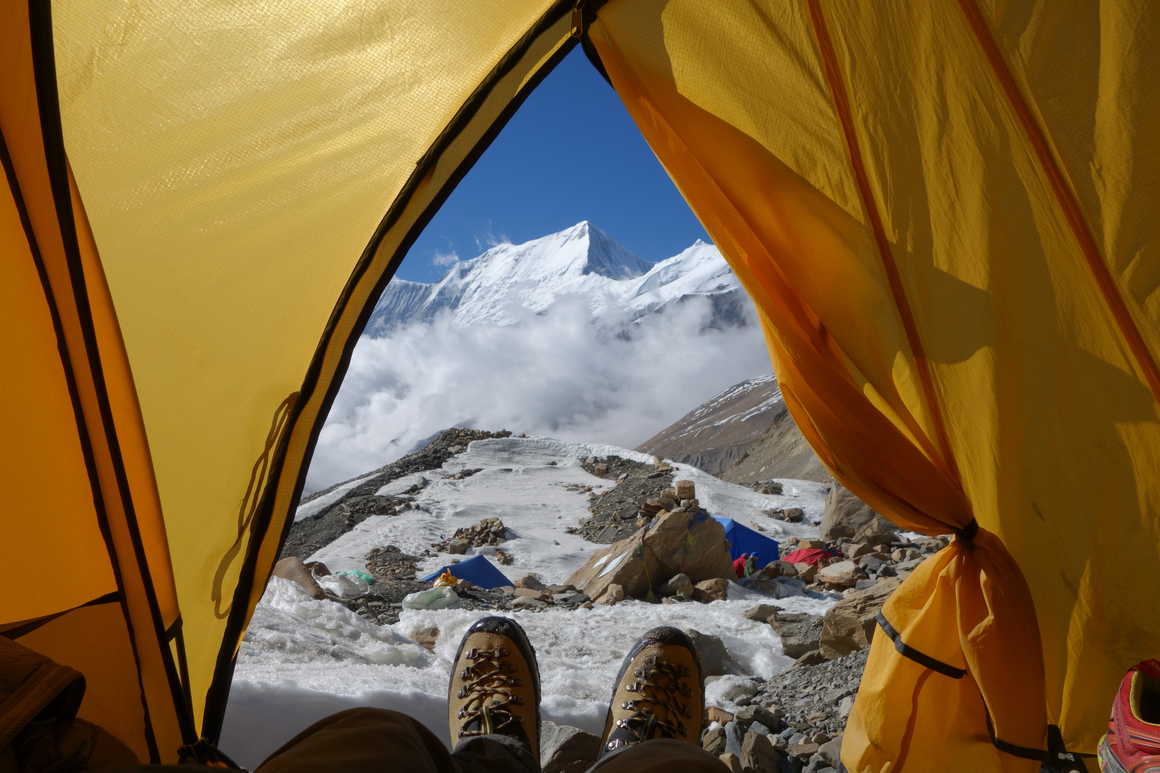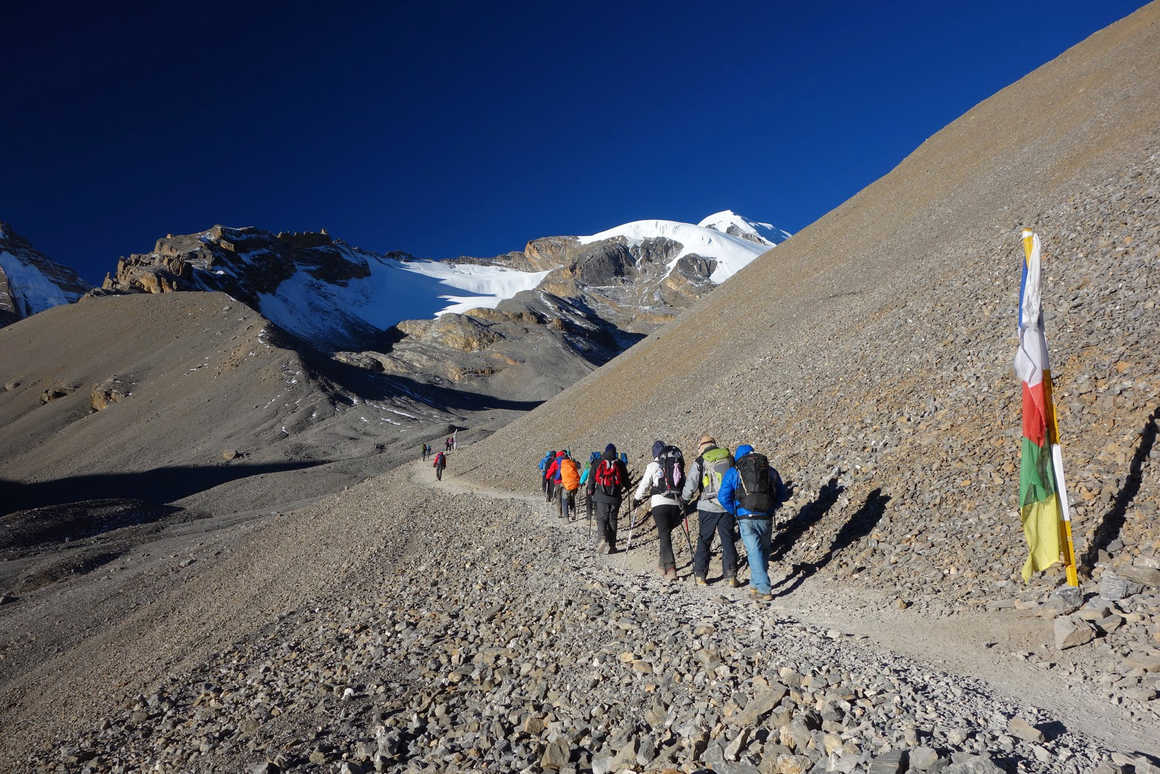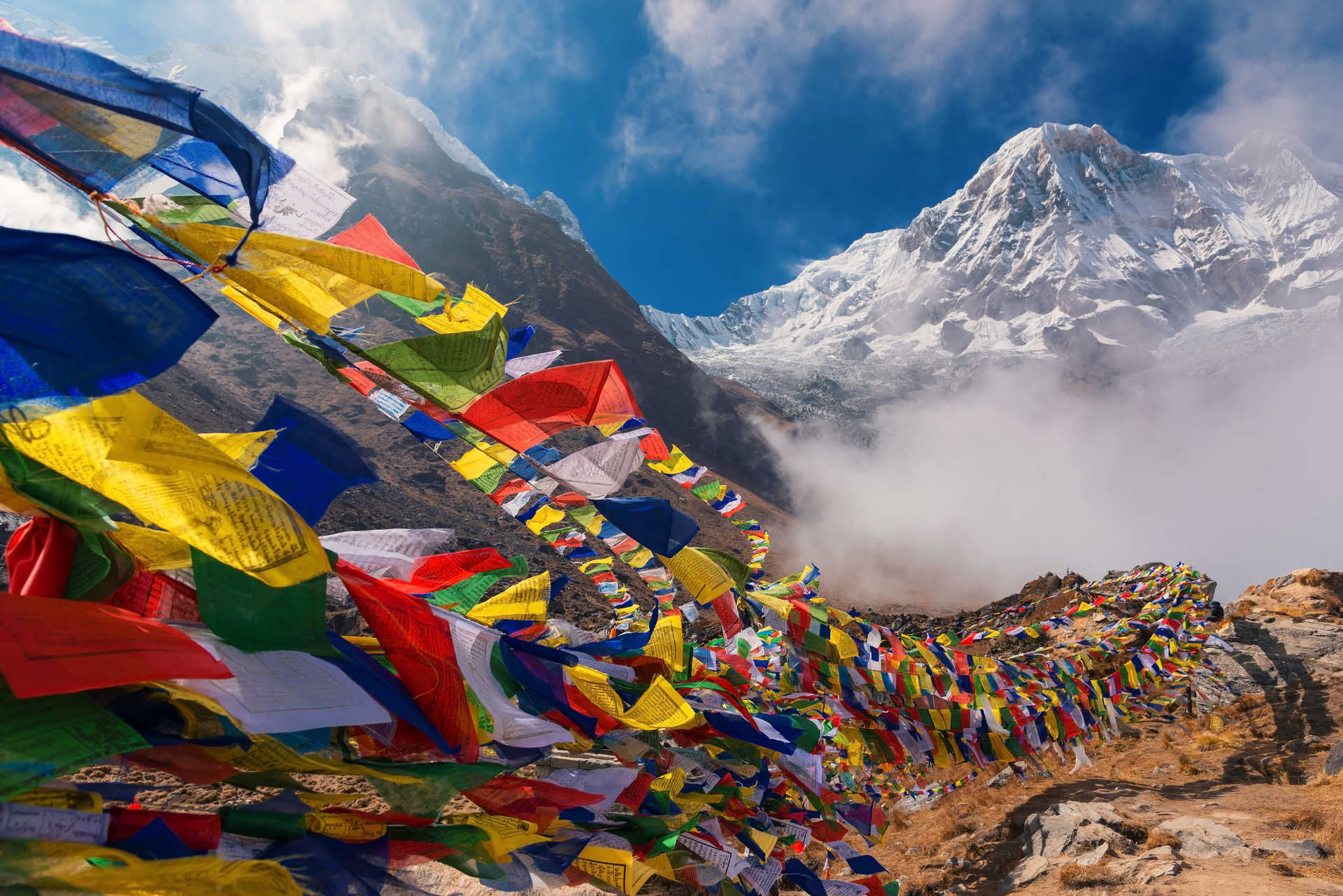Nepal Trekking - What to Pack
The Nepal packing list below is based on our personal trekking experience in Nepal and is a guide built over numerous treks in a variety of different regions. As the list is long and detailed, we recommend bookmarking this page as a future reference point. This packing list can be used for all hiking and trekking routes in Nepal, including the Annapurna Circuit, Everest Base Camp and the Langtang Trek.
Although this packing list can seem daunting and potentially heavy, many of the items listed below can be purchased or rented locally at Kathmandu, Lukla or Namche. Please note that local equipment is sometimes not up to scratch for any severely cold weather that you might encounter on the higher parts of your trek.
This Nepal packing list is comprised of gear that we have personally used or had recommended to us by experienced trekkers. We believe this gear provides the best value for money whilst also delivering the best performance.

Nepal packing list - Clothing
We recommend three key layers when trekking in Nepal.
Base Layer
The base layer clings to your skin and reduces airflow whilst allowing moisture to escape via its high wicking material. Reducing airflow means keeping your body heat trapped and is therefore perfect for the cold. Base layers will most likely not be needed on the lower sections of your hike.
The base layer we recommend is made by Smartwool. Providing market-leading lightweight, merino wool clothing, Smartwool are also very affordable.
1 x upper and lower base layer should be sufficient for a standard 12 day trek.
Second layer
The second layer, also known as the insulation layer, sits above your base layer and usually comes in a fleece material.
Whilst you can get a second layer for your legs, we believe that only a second layer for your upper body is needed as you will be wearing trousers.
For your torso, Kandoo recommend the Polartec 200 Fleece Jacket. This particular jacket is ideal for trekking in Nepal as it is lightweight, provides great warmth and yet allows good moisture release (breathability). We have recommended the 200 model as the 100s are not warm enough for the higher reaches of the Himalayas, whereas the 300s are slightly too heavy!
Third layer
The third layer, also known as the outer core layer, is a warm, waterproof jacket and trousers that you wear on the upper reaches of your mountain treks in the damper and colder sections.
There's a wide range of good quality jackets in this space, but from personal experience, we would recommend either the North Face Nuptse Jacket - a top of the range option, or the North Face Resolve Jacket which is a slightly more affordable option. Whilst the performance of the Nuptse jacket is amazing, the cost is high. However, this would be a lifetime investment as the Nuptse jacket should last you years! Although performance is slightly less, the Resolve is the cheaper option and is still a great all year-round jacket that is both lightweight and affordable.
Other good brands worth considering include Patagonia and Mountain Hardwear.
When purchasing trousers, look for warm, fleece-insulated ski pants. Trouser brands we personally recommend include Trespass, Helly Hansen or O'Neills.
General Trekking Clothes
In addition to the 3 layers mentioned above, you will also require trekking shorts and trousers. We have found that convertible trousers, like the trekking trousers produced by Craghoppers, are a great option as they save you cash on purchasing actual shorts.
When trekking all day you'll no doubt get a bit of a sweat up! Therefore, we recommend bringing at least 4 to 5 trekking t-shirts which you will almost certainly wear daily. Make sure your t-shirts are lightweight and breathable. Shirts by Hanes are a good option, as is anything from Icebreaker. Try to avoid cotton material shirts as they absorb moisture and make trekking quite uncomfortable!
Rain Clothing
Breathable Underwear
Clothing to avoid on your trek
Cotton: Cotton material clothing absorbs moisture, blocks breathability and is slow drying.

Nepal packing list - Headgear
Sun Protection Hat
Beanie or Head Band
Balaclava, Neckband or Buff
Sunglasses
Headlamp
Nepal packing list - Gloves and trekking poles
Outer Gloves
Your outer gloves need to be waterproof, warm and very durable. We recommend Gore-Tex gloves by Dakine.
Inner Gloves
Like any base layer, it is essential that your inner gloves are quick drying, light-weight and made from fleece material. Your inner gloves, like your base layer, acts as another skin layer. Kandoo recommend Pearl Izumi Thermal Lite Gloves which can also be worn as standalone gloves when the weather is slightly milder. Karrimor also produce great liner gloves.
Trekking Poles
A good set of trekking poles will reduce the impact on your joints and particularly your knees by up to 20%. This is especially beneficial when descending as the impact on your body increases exponentially. We suggest purchasing adjustable lightweight trekking poles that are simple to store, versatile and durable - around 350 grams per pair is about right. Black Diamond trekking poles are brilliant.
Nepal packing list - Footwear
Hiking Boots
Probably the most important item in your Nepal packing list, your hiking boots are what gets you from A to B. Getting the wrong size boot will impact heavily upon your trek and make you seriously uncomfortable. It is vital that your boots fit correctly and are well worn in. The simplest way to check for a good fit (although this not work for everyone) is to put your foot in the unlaced boot and push your foot as far as it goes forward - if you can then fit your index finger snugly between your heel and the back of the boot then that is about right. If it is not snug, but fits in easily then your boot is too large. Alternatively, if you can't fit your finger in then your boot is too small.
When purchasing a boot make sure you look out for key
characteristics:
·
Make sure your boot is not too heavy. Full
leather boots are generally too heavy, however, partial leather boots are
usually okay.
·
Make sure your boot is high top for good ankle
support with deep lug rubber soles for excellent traction.
·
Check out the lacing system, make sure it
incorporates speed hooks or d-rings for quick lacing and more secure ankle
support.
·
Finally, make sure it's waterproof! No one likes
to hike with wet feet.
Trainers (Trekking shoes)
When you arrive at your lodge you'll want a basic pair of run-around shoes. Trekking sandals with warm socks are also a super-comfortable way of getting around your camp or lodge. These are some trekking shoes and trekking sandals we very much recommend.
Trekking Socks
Thermal Socks
For the colder parts of the trek you'll need a couple of pairs of thermal socks. We suggest Smartwool thermal socks as they are super warm, really comfortable on the feet and have flat seams as supposed to raised seams that sometimes result in blisters. Other brands to consider include Wigwam and Bridgedale.
Gaiters
Microspikes
Great for giving you extra traction in unexpected snowy conditions. Particularly useful when crossing the Cho La Pass on the Gokyo Lakes trek. Easy to fit to your boots and light to carry in your rucksack.

Nepal packing list - Bags
Duffle Bag
Your bag size will very much depend upon your trekking itinerary. If you are trekking with a tour operator like Kandoo, porters will carry most of your gear. If this is the case then we would suggest taking an 80L duffle bag. The best duffle bags are waterproof and made from a laminate material. Your bag will need strong and durable zippers that can also be locked. Make sure you bring a small lock to secure your bag. Also look out for easy-to-access shoulder and hand straps.
Rucksack
Daypack
A daypack is an essential item. With porters carrying most of your gear, you'll still want to take a lightweight daypack to carry personal items such as sunscreen, camera, hat, wallet, passport, snacks etc. An ideal daypack will have compression straps to reduce the weight and stress on your back. Make sure your pack has side pockets to allow for your water bottles. The Osprey Talon is our recommended daypack.
Raincover
Nepal packing list - Sleeping accessories
Sleeping Bag
A warm sleeping bag is critical. As we have already noted, nights in Nepal, particularly the mountain regions, can get extremely cold! We strongly suggest a duck or goose down sleeping bag, however, they are quite pricey and if you would like to save money there is the option of a synthetic sleeping bag. If you do go for synthetic then please make sure that it has a warmth rating of at least -10 degree C. The best sleeping bags are mummy shaped with an insulated hood and that fits the contours of your body. We would also suggest buying a sleeping bag with a two-way zipper for greater insulation. Here are some brilliant mummy shaped sleeping bags. We personally suggest Highlander, Coleman and Mountain Hardwear.
If you decide to rent a sleeping bag, Kandoo can organise this for you before your trek.
Other Sleeping Accessories
Nepal packing list - other accessories
Dehydration can be very dangerous at high altitude and altitude sickness can often be prevented by keeping well hydrated. Make sure to drink between 2 and 3 litres of water every day. Depending on your backpack, you have the option of taking two standard 1 litre water bottles or one 2L hydration bladder like the Platypus Hydration Bladder.
Trekking Towel - A small to medium sized trekking towel is useful for drying off after a quick clean. Discovery or LifeVenture provide good, quick-drying trekking towels.
Small Locks - For the security of your backpack or duffel bag.
Pee Bottle or Funnel (optional) - Any woman who has needed to pee at night in sub-zero temperatures will be well aware of the benefits of a pee bottle! See Freshette Pee Funnels.
Book / Kindle - If you really want to get into the mood of high altitude trekking in Nepal then bring some reading about it. Our favourites are Ed Viesturs No Shortcuts to the Top and Into Thin Air by Jon Krakauer. Warning - the books can be addictive and somewhat unnerving!
Waterproof Ziplock Bags - To keep essentials like wallet, passport and electrical items dry and secure.
Camera / Video camera - The scenery and vistas you see on your trek in Nepal will be simply breath-taking and you won't want to forget a minute of it! We advise all our customers to purchase a camera before trekking in Nepal as there is literally nowhere else like it. Here are a few recommended Digital cameras. Please note that your camera needs to be light but still good enough to capture super high-quality images. If you want to video your trek then we seriously suggest getting a GoPro Hero 4 as they're super light, super high quality and super cool!
Playing Cards - There are no TVs in the lodges you'll be staying in in Nepal. Luckily playing cards are a great and very social way to keep you and your fellow hikers entertained.
Duct tape or Compeed - Although we try to avoid them, sometimes blisters still find us.
Notebook / Journal and Pen - Why not chronicle your incredible experience.
Nepal packing list - Medications and personal gear
Isotonic Powder - Trekking up mountains is tough and your body will need to replace your electrolytes. Isotonic powder is perfect for this and will increase your energy levels rapidly. Here are some Isotonic powdered drinks we recommend.
Basic First Aid Kit - Our guides always carry a first aid kit, however, there is no harm in taking one yourself. It's better to be safe than sorry. If you are trekking solo then taking a first aid kit is essential. For some good, compact outdoor first aid kits, click here - Outdoor First Aid Kits.
Diamox - Altitude sickness is a serious problem and whilst it can only be fixed by descending, certain medications like Diamox may help. Do note that Diamox does not cure altitude sickness, it can simply help prevent the onset of Acute Mountain Sickness (AMS). Always seek professional medical advice before ingesting Diamox. UK residents will need a prescription for Diamox. You can read more on Diamox here.
General Medications - Paracetamol is always handy, especially when trekking at altitude as headaches are one the most common symptom of AMS. We also recommend taking Imodium for diarrhoea in case of a stomach bug.
Toiletries - Remember to bring all your standard necessary toiletries. Make sure you use purified water when brushing your teeth as bacteria can enter through your gums. You will need at least 2 rolls of toilet paper - this can be bought locally but will often be very poor quality.
Suncream / Lip balm - Suncream and lip balm for obvious reasons. - Make sure your sunscreen is at least 30 SPF.
Blister Plasters - Compeed blister plasters are an essential item for long treks in Nepal.
Baby wipes - Water can be hard to find sometimes, wet wipes provide a quick and easy way to clean.
Hand Sanitizer - The trail can get dirty and these are an easy and effective way of cleansing your hands.
Oximeter - Completely optional, an oximeter tests the sp02 levels in your bloodstream to determine how the altitude is affecting your body. Our guides will provide their own and test you each day. Here are some Finger Pulse Oximeters that we recommend.










